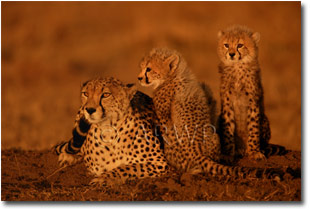Andy Rouse's Shots of the MonthText and photography copyright Andy Rouse. All rights reserved.
Editors note - This is the first in a series of articles by professional wildlife photographer Andy Rouse. Andy will be sharing some of his favorite images with us, along with enlightening and entertaining narration on how and where he captured the images. Enjoy!
HELLO and welcome to my first column for NPN. To launch the series I thought that Iíd show you a few of my favourite images from the past few years as a travelling wildlife photographer; if you want to know more about makes me tick then check out my bio.
Eye-to-Eye Hippo
Bertha is her name and she is the matriarch of a pod of hippos that I have worked with for several months whilst on commission in South Africa. I rarely give animals names as I find it a little too ďbunny huggerĒ but in this situation, when
 my life is at risk, I find it focuses my mind on the task at hand.
my life is at risk, I find it focuses my mind on the task at hand.
The image has a real intensity and menace because itís taken at eye level, from the waterís edge to be precise. After several days of careful observation to determine the pod size, and who was currently the boss, I started to sit outside of my vehicle to let the hippos gradually get used to my presence. Walking up to the water straight away would have been suicidal but most importantly, would have caused too much stress to the hippos. So I took each step slowly and gradually they accepted my presence. I should point out that I was fortunate enough to have the place to myself, I was alone in the privately owned park and had the freedom to move around and do as I pleased. Back to the story. Finally, I decided that the time was right and got into position, laying flat to the ground with my elbows and tripod in the shallows of the lake. From my observations I knew that the hippos wouldnít wake-up until late afternoon so I was in place well before they roused from their slumbers. A few gruff snorts announced their presence and tentatively they glided from the reeds to watch me from the middle of the river. Bertha, as the leader, was at the front but gave only a casual glance in my direction (the result of all that careful preparation). Experience has taught me never to be complacent when it comes to dangerous animals, so I made a point of counting all the members of the pod on a regular basis and noting where they were (even when below the surface). An hour passed and I hadnít taken a shot. I was just beginning to get restless when Bertha decided that it was time to have a closer look at me. Ducking below the surface she made her way towards me until she was less than 50 ft from the bank (I could tell by the bubbles coming towards me). Common sense screamed at me to leave and my bowels agreed. But chance favours the brave (or ignorant) so I stayed put. Breaking the surface slowly, she looked at me from a small raft of lilies.
Instantly, I saw the shot and took a small, careful sequence of images. Then, feeling that my audience was definitely over, I crawled slowly backwards into the bush, dragging the lens and tripod with me.
This image is certainly in my all time top 5 and I just love the intensity and mood of it. Itís a real beauty and the beast picture, although perhaps it is a little unfair to call flowers beasts!
Taken on Canon EOS 1D, 500mm F4L IS lens, Gitzo 1548 tripod with Wimberley head, WB Shade, AF One Shot, Exposure 1/200th at f6.3 ISO 100, digital processing - RAW file processed by CaptureOne DSLR and basic colour correction and image crop to window format under Photoshop CS.
 Polar Bear Encounter
Polar Bear Encounter
Perhaps one of the most photographed mammals in the world, thanks to the popularity of Churchill. When I first started off as a professional I really wanted to photograph polar bears but didnít want to get the same pictures as everyone else. So I decided to go to Svalbard, an arctic island north of Norway that has one of the highest polar bear populations in the world. The bears wander all over the sea ice so the only way to photograph them is to track them on snowmobile and camp on the shore. Ok, so itís cold, bloody cold, but providing you take sensible precautions (I took along my friend Arne, an Arctic survival specialist, polar bear fan and ace reindeer curry cook) then you can tolerate such extreme conditions. The worst moment is when nature calls and you have to pee, as getting your best friend out in Ė55 degrees is not fun at all. Anyway, back to the bears. Photography in such an environment is a real challenge as the bears are difficult and unwilling subjects, the cold saps both your energy and the cameraís power and it is financially very expensive. Still, being in such a wonderful environment and seeing a mayonnaise (they arenít white) bear ambling across the vastness of the wind-swept sea ice makes you forget such trivia. The picture shown was taken when a particularly large male (we estimated over 600KG) came over to our snowmobiles to take a look at what we were doing. Letís face it, all most bears see all day is blue ice, so we must have been irresistible (and smelly after 10 days of not washing). To get the low angle I lay flat on the ice and supported my lens on top of a Lowepro rucksack (the tripod had been shaken to pieces by the snowmobile). Arne commented with a wry smile that I looked like a seal laying down on the ice with my black snowmobile suit, I hoped that the polar bear didnít agree. The bear walked around us for several minutes, his huge weight crunching the fresh crust of ice. Finally he wandered off after a distant female, we breathed a collective sigh of relief and set off back to our camp.
I really like the feel of the image and the blurred out ice in the foreground. Sure I would have liked to shoot it slightly wider but my zoom lens was frozen solid so I had little option.
Taken on Canon EOS 1V HS, 600mm F4L lens, Fuji Velvia rated at 80, Exposure f5.6 at 1/320th sec, digital processing Ė slight colour correction of drum scan.
 Elephant Spraying Mud
Elephant Spraying Mud
This is the image that won the Animal Behaviour Category in the BBC Wildlife Photographer of the Year Competition. Normally I donít enter competitions, mainly due to the fact that I never win and end up on a downward spiral of self pity and planning nasty things to happen to the judges. In this case however I was persuaded that this image was so strong that I had to enter it, and bobís yer uncle it won.
The actual shot itself took some planning. I wanted a super low and wide angle of an elephant mud bathing, but try as I might I just couldnít get what I needed with traditional techniques. So, when the mud wallow was unoccupied, I placed my camera with a 17mm lens and an infra-red remote control on the edge. One look at the wallow told me exactly where the elephants liked to stand, so I pre-focussed just in front of the spot. After checking that the trigger worked, I loaded a fresh film and retired to the vehicle some 20 metres away. Soon enough a big bull trundled along for a bath, walking straight into the wallow and beginning his ablutions. I took my first couple of shots at which he abruptly stopped his business and stared directly at the camera. His trunk reached gingerly out and I knew that although it would be a great shot, to take one now would scare him and would as a result be likely to flatten the camera in the process. So I waited as he prodded and poked the camera hoping that it wouldnít topple over. My heart began to thump with trepidation as he scooped up a trunkful of mud; I knew what he was about to do. Pressing the motordrive switch on my remote I fired the camera just as he threw the mud directly at the lens, knocking it several feet back to wards me. Satisfied he carried on mud bathing and eventually left some 20 minutes later. I retrieved the camera and was pleased to say that it was intact, although completely covered in mud.
 The resultant image has captured the mud as it is inches from hitting the lens; itís made all the more special by the elephant sleeping in the background (waiting his turn for the bathroom no doubt). Iíve used remote triggers many times since but never with such spectacular results. For the record, the last time I used it a Hyena carried off the camera and lens into the bush never to be seen again. RIP my D60, at least it gave someone some fun for a few minutes!
The resultant image has captured the mud as it is inches from hitting the lens; itís made all the more special by the elephant sleeping in the background (waiting his turn for the bathroom no doubt). Iíve used remote triggers many times since but never with such spectacular results. For the record, the last time I used it a Hyena carried off the camera and lens into the bush never to be seen again. RIP my D60, at least it gave someone some fun for a few minutes!
Sifaka Dancing
One of the nicest weeks that Iíve spent in recent years was in Madagascar, where I went to photograph the endemic wildlife. In the deep south of the country lives a primate called the Verreauxís Sifaka, or ďdancingĒ sifaka as itís commonly known. Their nickname comes from their habit of skipping across roads and clear areas to get quickly from one fruit tree to another where they are not close enough to jump. Itís most comical to watch and as such they make great subjects for any nature photographer. Most of the time they just sit around feeding, but when they run they really go for it. The shot that you see here is one of the nicest that I managed to get, caught in mid-prance which was a lot harder to do that it sounds. If you ever get the chance to go then do as Madagascar is a jewel not only in terms of photography but in its unique and highly endangered wildlife.
Taken with Canon EOS 1V HS, Fuji Velvia pushed to 80, 70-200 f2.8L IS lens, handheld, Exposure f2.8 at 1/500th second, 81A warm-up filter, digital processing - slight colour correction of drum scan.
Swan Flying
Bang up to date, I look this image last month at Martin Mere Wildfowl and Wetland Trust Reserve in the UK. It shows a Whooper Swan flying back to its roost at the end of the day. I really love working with wildfowl of all kinds, but swans and geese are really my favourites. A year ago I made the decision that my wildfowl collection was absolutely rubbish, threw
 it all away and decided to start again. WWT reserves are excellent places for photography and on this particular day I had been accompanied by a group of photogrpahy students that I teach on a degree course. The weather was bright and clear but the swans were being particularly uncooperative. After a good few hours waiting, we all gathered in one hide for sunset, lenses hanging out of the hide expectantly. I told everyone to switch their cameras to AI Servo tracking autofocus, light up all the autofocus points and choose the minimum aperture value for their lenses (which would by default choose the fastest shutter speed). When taking flight shots you have to go with the right mind set; you either do action or portraits but not both. The sun gradually started to set, and as it approached the horizon a light mist rolled across the lake. Out of the mist came a flight of 4 Whooper swans. From watching their flight patterns all day I knew that they would bank and fly right in front of the hide. Motioning the group to get ready, I locked onto the final bird, which lagged slightly behind the rest and gave me some space between them. As it banked and flew right by us I had enough time for 3 shots (the 1Ds is not the fastest camera ever made) and the one that you see here is the pick of the bunch.
it all away and decided to start again. WWT reserves are excellent places for photography and on this particular day I had been accompanied by a group of photogrpahy students that I teach on a degree course. The weather was bright and clear but the swans were being particularly uncooperative. After a good few hours waiting, we all gathered in one hide for sunset, lenses hanging out of the hide expectantly. I told everyone to switch their cameras to AI Servo tracking autofocus, light up all the autofocus points and choose the minimum aperture value for their lenses (which would by default choose the fastest shutter speed). When taking flight shots you have to go with the right mind set; you either do action or portraits but not both. The sun gradually started to set, and as it approached the horizon a light mist rolled across the lake. Out of the mist came a flight of 4 Whooper swans. From watching their flight patterns all day I knew that they would bank and fly right in front of the hide. Motioning the group to get ready, I locked onto the final bird, which lagged slightly behind the rest and gave me some space between them. As it banked and flew right by us I had enough time for 3 shots (the 1Ds is not the fastest camera ever made) and the one that you see here is the pick of the bunch.
Processing this RAW file proved to be a challenge, as the low light levels and high ISO (200) generated more noise than I would like. Sure I could reduce the noise during processing but that in turn would reduce subject detail. So after several minutes experimenting in CaptureOne DSLR I finally found the best balance and converted it to a 16 bit RGB TIF. I deliberately turned the sharpening off as this would ruin the soft effect of the image.
Taken with Canon EOS 1Ds, 300mm F4L IS lens, handheld, exposure 1/250th at f4 compensated deliberately by Ė1 2/3rds stop, ISO 200, WB Shade (corrected during RAW processing), AI Servo, digital processing Ė noise reduction of RAW during processing using CaptureOne DSLR, basic colour correction under Photoshop CS.
And finally...
 As I write this column Iím preparing to leave for Africa to work on my forthcoming Cheetah book. So hereís one of my favourite images of this wonderful cat, taken a year ago in South Africa.
As I write this column Iím preparing to leave for Africa to work on my forthcoming Cheetah book. So hereís one of my favourite images of this wonderful cat, taken a year ago in South Africa.
Well thatís all from me, I hope that you have enjoyed my stories and snapshots. Please feel free to provide any positive comments to Jim about what youíd like me to write about in future issues and Iíll be back next month when I return from my African adventures. If you want to see more of my and my partnerís work, then check out our website Ė www.andyrouse.co.uk which has a fully searchable database. Now itís time to start packingÖ. Whereís my underwear?
AR-NPN 1153
Andy Rouse is a professional wildlife photographer based in the U.K. His professional credits include hosting the Discovery Channelís Wildlife Photographer TV series, and the publication of six books, including his soon-to-be-released The DSLR Masterclass. Andy's images are represented by NHPA and Getty Images and are sold worldwide. To learn more about Andy, check out his NPN bio. To view more of Andy's work, visit his website at www.andyrouse.co.uk.
Comments on NPN wildlife photography articles? Send them to the editor.


| 


